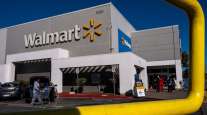Logistics Companies Aim to Ease Returns, Keep Costs Low Amid E-Commerce Rise

As the continued rise of e-commerce increases the number of product returns, retailers and shippers are working to ease the returns process to boost customer satisfaction. They’re doing so by turning to logistics providers for technology and services that can optimize their reverse logistics networks and keep costs low.
RELATED: Retailers Turn to Logistics Providers to Help Manage Returns Process
“It’s critical to make returns fast and easy for the consumer without breaking the bank,” said Perry Belcastro, senior vice president of operations for Saddle Creek Logistics Services. “Optimizing the process, moving it closer to the consumer and controlling transportation expenses are important steps.”
Shippers and retailers work with their logistics providers to shore up their infrastructure, making sure their information systems, distribution networks and transportation capabilities are prepared to handle surges in return volumes, Belcastro said.
Saddle Creek Logistics, based in Lakeland, Fla., ranks No. 30 on the Transport Topics Top 50 list of the largest logistics companies in North America.
Katherine Cullen, director of industry and consumer insights for the National Retail Federation, said 58% of holiday shoppers expected to return or exchange holiday gifts this year. The vast majority of those will do so in January.
However, UPS Inc. estimated that the peak day for returns hit on Dec. 19, with an estimated 1.5 million returns. The parcel giant also projected that 1.3 million packages would be returned on Jan. 3.
UPS’ “Pulse of the Online Shopper” study found that 75% of consumers have shipped returns back to the retailer, 79% of e-commerce shoppers said free shipping on returns is important when selecting an online retailer, and 44% said the top issue encountered when returning an item online is paying for return shipping.
Global POTOS Executive Summ... by on Scribd
Jonathan Lyons, a spokesman for FedEx Corp., said research from the consulting firm Invesp found that nearly 95% of consumers said they will buy something again if the returns are easy, and 79% stated that free return shipping is a must.
UPS and FedEx rank Nos. 1 and 2, respectively, on the Transport Topics Top 100 list of the largest for-hire carriers in North America.
To help manage costs, good retailers look for logistics partners that do more than move a box, said Tony Sciarrotta, executive director of the Reverse Logistics Association.
Logistics providers can offer a range of other services, from restocking products to providing custom refurbishing.
“That is where we add value,” said Alec Hicks, group director for supply chain excellence at Ryder Supply Chain Solutions. Ryder helps customers gather data on what is returned, why and how much returns cost. That information allows shippers to improve their processes and policies and mitigate the costs of returns.
“We can design the return supply chain just as effectively as we can design the forward supply chain,” Hicks said.
Ryder Supply Chain Solutions, a unit of Ryder System Inc., ranks No. 12 on TT’s Top 100 list of for-hire carriers.
Andy Moses, senior vice president of global products for Penske Logistics, said third-party logistics providers can address several pieces of the returns puzzle that include testing, dismantling, repairing, recycling or disposing of a product.
However, controlling return shipping costs is increasingly important as demand grows for free returns.
Third-party logistics companies “usually have established relationships with carriers and economies of scale that can be useful when negotiating rates,” Saddle Creek’s Belcastro said. “They also are likely to have established distribution facilities near end customers, so they can minimize transportation costs and process returns more quickly to ensure customer satisfaction.”
Penske’s Moses said minimizing returns starts with ensuring order accuracy from the outset. Penske Logistics offers its ClearChain technology to connect to shippers’ order management systems. The technology can clean up information errors, which improves accuracy.
“We have the same processes to aggregate and optimize whatever orders there are on that given day of the week or the month,” Moses said, adding that for shippers, various economic consequences are tied to returns as well as the rate at which the returns are salvageable for resale. “We’re here to manage processes.”
Penske Logistics ranks No. 19 on TT’s Top 100 list of for-hire carriers.
Kevin Warren, UPS’ chief marketing officer, said the company provides technology-driven returns services, including UPS Returns Manager. The portal offers shippers control and visibility over their returns.
FedEx has launched FedEx Returns Technology, which gives high-volume merchants and online retailers visibility into returns, a way to track shipments, manage inventory, analyze returns trends and make informed decisions based on the return behavior of shoppers. The technology is used in more than 1,700 FedEx Office locations across the United States, enabling merchants to offer their customers the ability to drop off returns that can be inspected and packed. In some cases, it can lead to a faster refund.
While a simple return policy is a great way to attract consumers, it can lead to customers who want to test-drive the goods, said Ashfaque Chowdhury, president of supply chain for the Americas and Asia Pacific at XPO Logistics.

Customers return packages at a FedEx store. FedEx also launched a returns technology for merchants and online retailers. (FedEx Corp.)
The return rate for online retailers is anywhere from 10% to 30%, he added.
Chowdhury said XPO’s biggest reverse logistics partnership is with a large footwear and apparel customer. “It’s an omnichannel facility that we designed to dramatically improve reverse processing time,” he said. “Products flow in through wholesale and e-commerce channels, and we get them back into the supply chain 10 to 15 times faster than before.”
To efficiently manage returns, businesses must be able to plan ahead for the storage and labor requirements, Chowdhury said. “We’ve developed predictive analytics that can forecast the future rate of return for products and adjust for seasonality,” he said.
Greenwich, Conn.-based XPO Logistics ranks No. 1 on TT’s Top 50 list of the largest 3PLs in North America.
Ryan Martin, president of distribution services for ITS Logistics, said the reverse logistics process is heavily dependent on the retailers’ return policy, and free returns can change shoppers’ buying habits, encouraging them to buy multiple sizes or colors to try out products.
The policies and processes surrounding reverse logistics can vary greatly depending on the commodity consumers are returning, Hicks said.
Large appliances, for example, are hard to return due to their size and weight, but have enough value that refurbishing or reselling the items is worthwhile. With low-cost items, it may make sense for a retailer to issue a credit without requiring the article be returned.
There is a natural peak in returns following the winter holidays, but ITS Logistics’ Martin said peak seasons can vary by product.
Because 3PLs typically have flexible space and staffing, they can more readily handle spikes in return volume without incurring the associated overhead investment, Saddle Creek’s Belcastro said.
Ryder handles distribution for a major beverage brand that has a peak season in the summer. “We take advantage of that by subletting the space and providing labor and warehousing capabilities to help during a retail peak,” Hicks said.
Penske’s Moses said artificial intelligence can help retailers better predict what will happen in various scenarios.
“As time goes on, AI is going to play significantly in this arena. It will help the retailers make better pricing decisions,” he said, adding it also will help the 3PLs make better cost-management decisions.




